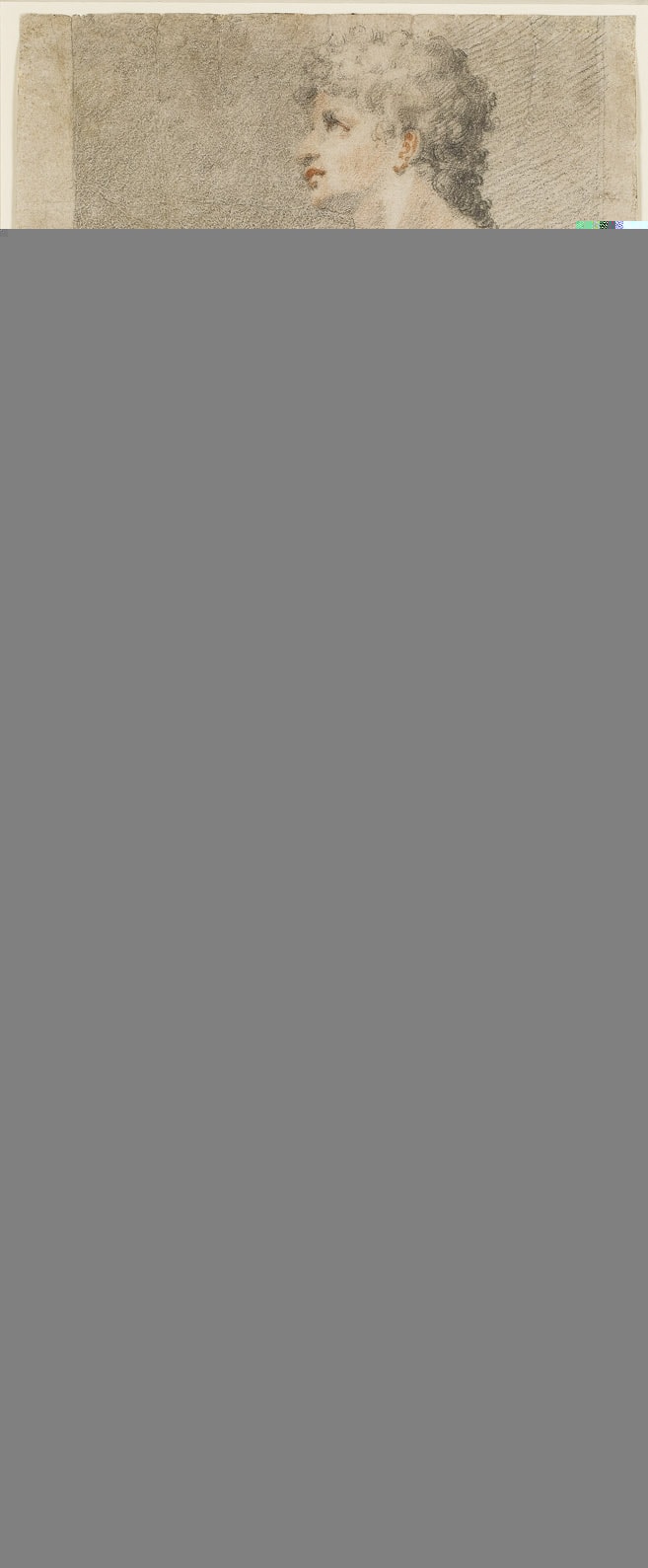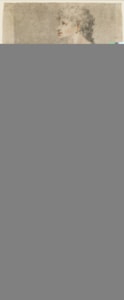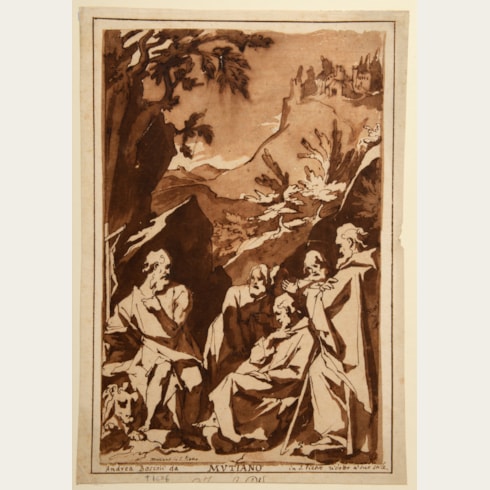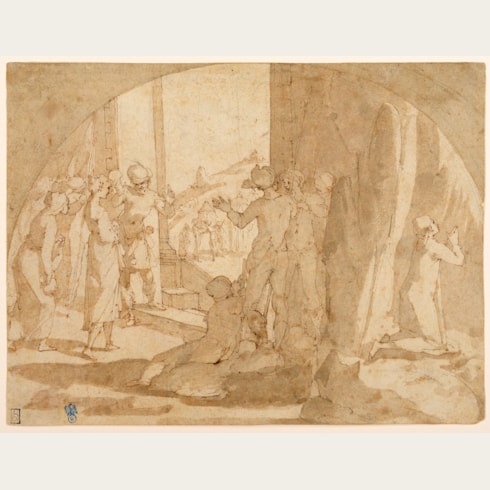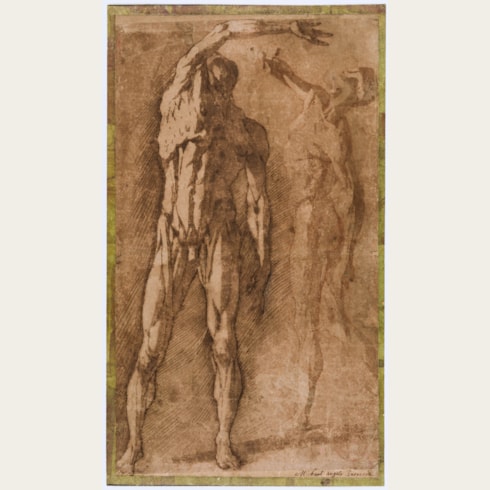Andrea BOSCOLI
(Florence 1560 - Florence 1608)
Saint Sebastian, after Rosso Fiorentino
Numbered 70 5 at the lower right, and 4(?)3 at the lower left.
Inscribed Cecho Salviati on the verso.
420 x 170 mm. (16 1/2 x 10 5/8 in.)
This fine drawing is a copy of the figure of Saint Sebastian in Rosso Fiorentino’s altarpiece of The Virgin and Child Enthroned with Ten Saints, today in the Palazzo Pitti in Florence. Signed and dated 1522, the painting was commissioned by the Dei family for their chapel in the Florentine church of Santo Spirito, where Boscoli would have been able to see and study it more than sixty years later. Rosso’s altarpiece had been highly praised by Vasari, who noted that it was ‘painted with marvelous grace, draughtsmanship, and vivacity of colouring’, and the painting seems to have had a profound impact on artists working in Florence in the later 16th century. As Julian Brooks has noted of the present sheet: ‘One drawing by Boscoli records a pose which obviously impressed him, and may have been used as a reference, although the dating is problematic; the style seems relatively late. This is a study…that he made of a figure of St. Sebastian from Rosso’s Santo Spirito Dei altar-piece. A highly finished drawing, it features a careful construction, with very defined limits to the shading on the left and right edges, which suggests that it was designed to be kept. Boscoli uses variants of the same pose, with the right foot raised on a pedestal and the head looking sharply upwards, in his own work several times.’
Boscoli first used a variant of this pose for a figure of Apollo in his extensive fresco decoration of the Villa di Corliano, near Pisa, painted in 1592. He later returned to the pose for the figure of Saint Sebastian in his altarpiece of The Virgin and Child with Saints Andrew and Sebastian, painted in 1600-1602 for the Rossini chapel in the Duomo in Macerata. While the figure of Saint Sebastian in the Macerata altarpiece shows some similarities with the pose of the saint in this drawing, Boscoli’s preparatory drawing for the painting, in the collection of the Biblioteca Reale in Turin, displays a much closer relationship with the figure taken from Rosso’s painting, and must have been based on the present sheet.
While some of Boscoli’s copy drawings may have been intended as models for prints, most seem to have been made to record a pose or composition that he found particularly striking. At the same time, the highly finished nature of the present sheet and the use of framing elements on either side of the figure would suggest that the drawing may have been intended as an autonomous work of art. As Brooks points out, ‘although this pose was one that Boscoli loved and used several times, this drawing has been carefully made…and may have been intended for presentation or sale if not for his own purposes.’
Andrea Boscoli trained in the Florentine studio of Santi di Tito and was admitted into the Accademia del Disegno in 1584. He visited Rome as a young man in the early 1580’s and, like many artists before him, avidly copied the frescoes of Polidoro da Caravaggio that decorated the facades of several palaces there. Between 1582 and 1600 Boscoli worked primarily in Florence, with brief stays in Siena and Pisa. His earliest known painting is the Martyrdom of Saint Bartholomew, painted in 1587 for the cloister of the Florentine church of San Pier Maggiore. He was also involved in the decorations for the apparati celebrating the marriage of the Grand Duke Ferdinando I de’ Medici to Christina of Lorraine in 1589.
In 1592 Boscoli completed a fresco cycle for the Villa di Corliano at San Giuliano Terme, near Pisa, and the following year painted an altarpiece of The Annunciation for the Chiesa del Carmine in Pisa. In 1597 Boscoli painted a Visitation for the Florentine church of Sant’ Ambrogio, followed two years later by a Crucifixion for SS. Apostoli, now lost, and an altarpiece of The Preaching of Saint John the Baptist in the church of San Giovanni Battista in Rimini, signed and dated 1599. Between 1600 and 1605 Boscoli worked mainly in the Marches, painting frescoes and altarpieces for patrons and churches in Fano, Fabriano, Macerata, Fermo and elsewhere, while the last years of his career were spent between Florence and Rome.
Relatively few paintings by Boscoli survive today, and it is as a draughtsman that he is best known. His drawings were highly praised by his biographer Filippo Baldinucci (who noted that ‘he drew so well...without lacking a boldness and an extraordinarily skillful touch’) and were avidly collected. Some six hundred drawings by Boscoli are known, with significant groups of drawings in the Uffizi in Florence (many of which were once part of the extensive collection formed by Cardinal Leopoldo de’ Medici), the Istituto Nazionale per la Grafica in Rome and the Louvre.
Provenance
Literature
Exhibition

